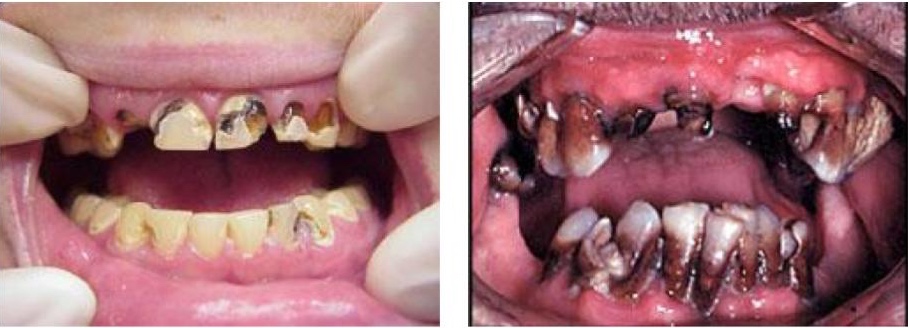Meth before and after
Meth is a drug that takes its brutal toll on the bodies of thousands of users in the US every year. Meth mouth, meth skin, meth scars, meth sores, meth face, and meth teeth are all possible physical side effects of meth addiction.
Not everyone who uses the drug ends up being the subject of a frightening before and after meth picture. But for many meth users, the damage done to the body is nowhere as devastating as the psychological and internal damage.
This page shows the traumatic effects of the drug, but recovery from addiction is possible.
It’s possible to recover from meth addiction. We offer meth addiction rehab.
What is Meth?
Methamphetamine, commonly known as meth, is a powerful central nervous system (CNS) depressant.
It is classified as a Schedule II drug because of its high potential for abuse. When used, they can potentially lead to severe psychological and/or physical dependence.
If you or someone you know is addicted to meth, we offer rehab options via telehealth or in-person addiction treatment in Arizona.
What Does Meth Look Like?
Meth usually comes in a white powder form that can be made into a pill or hardened into a shiny rock known as a crystal.
In addition to the white powder, meth also comes in other colors including brown, gray-yellow, orange, and pink.
Crystal Meth
What does crystal meth look like?
Crystal myth looks like clear crystal chunks or shiny blue-white rocks that resemble ice or glass. Hence why it’s commonly referred to on the streets as ice and glass.
How is Meth Taken?
Meth can be taken in many different ways.
Some users snort or eat the powder, while others mix it with a liquid and inject it into their bodies. Another common method of using meth is smoking the crystal version using a small glass pipe.
Even though the drug is used by virtually all ages, it is most commonly taken as a “club drug” by young adults. However, the internet is also changing the experience that meth users have with the drug. Now there are online communities, social media groups, and Zoom rooms where users can buy, consume, and share their experience with other users.
Faces of meth
Whether it’s used legally or illicitly, Methamphetamine is an extremely powerful, dangerous, and addictive drug that changes the way the brain works over time. Due to its potency, users can quickly develop a dependency on the drug.
Once dependent or addicted to meth, stopping or decreasing consumption can be extremely difficult and painful. Referred to as withdrawal, the debilitating feeling of sickness is one of the main reasons users find it so difficult to quit using meth – especially quitting cold turkey.
The good news is that recovery from a meth addiction is POSSIBLE! Just read Dejah Marie Hall and Jason Wickline’s recovery stories featured in this post.
We offer online meth rehab
We’ve helped hundreds of people to get off meth. You don’t have to face addiction on your own. We have flexible online telehealth options to help you or your loved one get their life back.
What does meth do to you?
When someone uses meth, I guess you could say that it goes straight to their head!
They feel an intense rush of energy and good feelings – A euphoria referred to as “the flash”.
When meth enters the body it causes a release of dopamine, the chemical key that unlocks pleasure in the human brain. Simply put, dopamine is a natural chemical that causes us to feel good. The more dopamine that’s released in the brain, the more pleasure we feel.
Research shows that meth use results in about 3.5 times more pleasure than what’s felt from cocaine use and about 6 times what our brain can naturally feel on its own.
This initial feeling of pleasure is what causes many users to become trapped or addicted to meth. They begin to chase the euphoria, trying to reproduce the pleasurable feelings by consuming the drug again and again.
Did you know that your health insurance may cover 100% of the cost of your meth addiction treatment?
Contact UsThe irony is that every time a user takes the drug, they feel less pleasure from the same dose. They’re forced to increase the amount they consume in order to feel the same effects they once did with a smaller dosage. This is referred to as developing a tolerance to the drug.
What makes Meth even more appealing is that the high lasts significantly longer than the high from other drugs. However, there is a general rule that can be applied to all drug use – “The higher the climb, the harder the fall.”
As the drug wears off and the flash begins to fade, the good feelings are quickly replaced by anxiety, fear, anger, and edginess – commonly known as “the crash”. Studies show that extensive meth use can cause permanent changes to the brain and make it extremely difficult for users to experience pleasure – with or without the drug.
Recovering from A Meth Addiction
A Substance Abuse Disorder (SUD) is an addiction or abuse of a substance. This often leads to health problems, problems at school, home, or work. Because meth is powerful and the effects are long-lasting, addiction is likely. While it is not easy to recover from meth addiction, it is possible.
The euphoria that meth causes often causes instant addiction. After one use, many people have a desire for more that cannot be overcome.
Meth addicts continue usage despite seeing how damaging the effects can be. The physical and mental effects of meth get worse with use. This is not effective in helping someone stop their addiction.
Substance Use Disorder treatment is an effective method of helping an addict recover. They can regain control of their life and choices.
The Serious Physical Side Effects of Meth Abuse
In addition to the short and long-term psychological effects of meth abuse, the drug can also have severe effects on the user’s physical appearance and overall health.
Meth can cause what’s commonly referred to as meth mouth, where the user’s teeth begin to rot and break apart. It also causes a loss in appetite which can lead to dramatic weight loss.
Users report their skin becoming very itchy, which leads to sores and scabs from continuous and uncontrollable scratching.
Meth use also causes the development of distinct facial sores and a sallow complexion, as shown in the image below:
Source: U.S. Centers for Disease Control & Prevention (CDC)
However, perhaps its most destructive effect on human health is invisible to the naked eye. The brain damage inflicted on an individual by the use and abuse of methamphetamine is extensive and, sometimes, permanent.
Brain Damage from Meth Abuse
Methamphetamine is toxic to brain cells. What that means is that when someone uses meth, over time it changes both the structure of the brain and the way it functions. This leads to difficulty with memory, managing emotions, thinking/decision making, and mood regulation. Studies show that chronic users experience increased anxiety and psychosis, profound paranoia, and an increased risk of both stroke and Parkinson’s Disease.
These changes in the brain may explain why meth addiction is difficult to treat, and why many recovering meth addicts end up relapsing.
Recurring Psychosis from Meth Use
The psychotic symptoms can often last for months, and in some cases years, after an addict stops using.
Studies show that high-stress levels can trigger the recurrence of meth-related psychosis. The recurring psychosis experienced by ex-meth addicts is characterized by paranoia, visual and auditory hallucinations, and delusions.
One of the most common examples of a meth-induced psychosis is meth bugs! This occurs when users feel like there are bugs crawling under their skin.
Meth Mouth – How does meth ruin teeth?

Perhaps the most visible sign of chronic meth abuse is meth mouth, a condition characterized by severe tooth decay and gum disease.
The extensive tooth decay is attributed not only to poor nutritional choices but also to the fact that meth use causes both psychological and physiological changes which results in dry mouth and extended periods of bad oral hygiene.
As shown in the photos below, teeth can become rotten, stained, blackened, and deteriorated. In some cases, they become so crumbly and deteriorated that they cannot be fixed and must be removed.
Meth is also quite acidic. The acid and dry mouth erodes tooth enamel and leaves extensive carious lesions (cavities) – among other problems. If left untreated it can even result in trismus, more commonly known as lockjaw.
Source: U.S. Depart of Justice Archive – Meth Awareness
Addicts tend to be inherently anxious because of their drug use, and meth addicts are no different.
Severe anxiety in meth users can cause bruxism – Constant grinding of teeth and jaw-clenching. With the teeth already being fragile, the constant grinding speeds up the damage and degeneration.
In fact, one NIDA study of over 500 meth users found that:
- 96% had carious lesions or cavities
- 58% had untreated tooth decay, compared with 27% of the general U.S. population
- Only 23% were able to keep all of their natural teeth, compared to 48% of the population
- 40% said they were self-conscious or embarrassed because of their dire dental issue
Meth Skin Damage
Another profoundly negative effect of meth use is the destruction of both blood vessels and muscle tissues in the user’s body. Nowhere is this more visible than on the skin.
Repeated meth use causes users’ skin to be unable to heal itself as normal and causes it to look prematurely aged.
The destruction of blood vessels and muscle tissue in the face prematurely ages the user. These photos show the skin’s deterioration over only 2.5 years.
Source: Multnomah County Sheriff’s Office, Oregon / Faces of Meth, 2005
What Does Meth Skin Look Like?

Meth users are highly susceptible to acne on their face and other parts of their body. The acne often develops into sores and meth scars that can take a long time to heal.
Additionally, the skin will usually lose its elasticity, making meth users appear far older than they actually are.
Meth use leaves the skin feeling itchy and dry skin. The dryness, plus the “meth bugs” sensation causes addicts to pick at their faces and other affected body parts. The subsequent wounds often leave permanent scars.
Lastly, this constant picking at the skin can actually become a behavioral disorder, known as dermatillomania. The disorder is classified as a body-focused repetitive behavior (BFRB).
Illicit Street Meth Manufacture
If you’ve ever watched an episode of the Netflix hit series Breaking Bad, you’re probably familiar with meth superlabs, kitchens, cooks, and explosions.
Many of the scenes in Breaking Bad where Jesse and Walt were cooking meth aren’t too far off from reality.
On a small scale, meth is literally cooked up in countless kitchens and basements across the United States.
One of its base ingredients pseudoephedrine is the active ingredient in some over-the-counter cold medicines like Sudafed. However, due to tight controls in the U.S., it has become very difficult for meth manufacturers to get pseudoephedrine and pseudoephedrine-based products in bulk.
Most of the illicit meth sold in the U.S. is produced by criminal organizations in Mexico and trafficked into the country for sale.
Producing pure meth or crystal meth is rare, because additional chemicals, like antifreeze, drain cleaner, and battery acid, are often added to strengthen the potency of the finished product.
As “Breaking Bad” also showed, the chemicals used in meth manufacture are potentially explosive. The use and handling of such dangerous chemicals by a meth cook is a recipe for absolute disaster, as many of these cooks are disorientated and dysfunctional meth addicts themselves.
Meth lab accidents are common, often leaving the cook and other workers either severely burned, disfigured or dead.
Running a meth lab has other health hazards as well. For example, a typical “lab” or “kitchen” produces a significant amount of toxic waste. As the result of manufacture, 1lb of meth will create 5lbs of actual toxic waste, and whoever is exposed to this toxicity risks possibly fatal poisoning.
Common Meth Street Names
There are many common names for meth on the street. These include:
- Beanies
- Brown
- Chalk
- Crank
- Chicken Feed
- Cinnamon
- Crink
- Crypto
- Fast
- Getgo
- Ice
- Methlies Quik
- Mexican Crank
- Redneck Cocaine
- Speed
- Tick Tick
- Tweak
- Wash
- Yaba
Real Life Meth Addiction Recovery Stories

Jason’s Story of Recovery from Meth Addiction
“Getting clean and sober didn’t promise me that I would be perfect every day, it just promised me that I would have a chance” – Jason Wickline.
If you were to meet 41-year-old Jason Wickline, a now happily married father, you’d probably find it hard to believe he was once a meth addict.
Today, he’s healthy and muscular – unrecognizable in comparison to when he was suffering from a severe addiction to meth.
Jason suffered tremendously from his addiction and lost custody of his young son in the process. He described himself then as no more than “an empty shell. I’m 5-foot-8, and I only weighed 120 pounds. I was a dead man.”
This is Jason Wickline’s story:
In 2015, Jason Wickline was arrested at his Mount Hope home, on charges of methamphetamine manufacturing. But this wasn’t his first time in handcuffs…he had already spent the past 15 years in and out of jail.
At the time of his arrest, Jason was a single dad, and a hopeless addict cooking meth just to support his habit.
Not only was he charged with meth manufacturing, but he was also hit with an additional child neglect charge that resulted in him losing custody of his 4-year-old son Krystian.
Jason explained, “As they were walking Krystian to the car, he turned around to look at me, and said, “Daddy, I love you, and I’ll never forget you.” He was 4 and thought he would never see me again. I was bawling my eyes out. I had no idea what was going to happen to my kid at that point.”
Unfortunately, or some may say, fortunately, this was Jason’s true rock-bottom moment.
It was the pivotal point in his life when he realized that if he didn’t change, nothing else would.
If he didn’t stop using meth, he’d never regain custody of his son! His addiction would continue to destroy his life.
“I knew my life was never going to be the same again. I knew that insanity I had been living in was finally over”, says Jason.
At his sentencing, the judge gave Jason a life-changing opportunity. He offered him the chance to go to a long-term addiction treatment program. Jason seized the opportunity, and to his credit, he kept his word and stayed in the program for 13 months.
The judge did however put Jason on a 30-month probation period, with strict and clear conditions – find adequate housing, and stay sober.
Knowing full well there was simply no other way but to find a stable home in order to get his son back, he kept his word once more.
Our telehealth program allows you to receive a high level of personalized care from the comfort of your own home.
Today, Jason is truly a changed man and a living example of hope and recovery. He’s now happily married to his wife Shanna, and he’s regained custody of Krystian who is now 9 years old.
Jason says that he wants to make Krystian proud, and we’re certain that he will!
Like many recovering addicts, Jason is actively giving back to the recovery community. He regularly attends meetings and volunteers at addiction treatment programs.
Along with his wife Shanna, Jason also actively promotes the recovery website: www.morethanaddiction.org/.
Jason had to lose everything before finally deciding to beat his addiction and commit fully to recovery.

Source: Reproduced with the kind permission of Jason Wickline

Dejah’s Story of Recovery from Meth & Heroin Addiction
To celebrate her 4-year anniversary of recovery from heroin and meth addiction, Dejah Hall (then 26 years old) posted a series of dramatic transformational photos on her Instagram.
Being an attractive woman, her post rapidly went viral, even more so when it was later re-posted on Facebook by the “Love What Matters” page.
From ages 17 to 22, Dejah struggled with an addiction to a variety of drugs.
Her history of drug use began at age 17 when she first took a prescription pill at a party. Stress and problems at home are what prompted her to take the medication.
She quickly became addicted to prescription meds and reports taking up to six pills at a time – every day until age 20 when she attempted to stop.
Dejah started to receive medication-assisted treatment at a methadone clinic for her drug dependence. However, unfortunately, she missed 3 consecutive days of treatment and was kicked out of the program.
She then tried to quit the pills cold turkey but suffered from debilitating withdrawal symptoms that led her to try heroin as a way to stop the pain. After just her second hit of heroin, she fell in love with the high. Her addiction to heroin led her even further down the rabbit hole and she soon after tried meth. At one point in 2012, she was injecting both heroin and meth.
It may seem somewhat strange to pray to God, asking desperately for help, and then to be arrested within the space of a couple of hours, thinking that your prayers were actually answered, but that’s exactly what happened. Visiting her grandfather one day, he told her she was hurting him with her endless drug abuse. Dejah went into the bathroom, got down on her knees, and said her prayer.
After leaving her grandfather’s house, she was promptly arrested by local police on a number of outstanding felony warrants and was to spend the next 2-3 weeks in county jail, painfully going through a jail-induced withdrawal – without any medication whatsoever. As she says her self, “It was hell, but I am still alive.”
Dejah is now a busy Mom, happy to be in a position to not only share her story, but also to offer the following advice to those who find themselves where she once did: “Get to NA or AA, get a sponsor, and work your Steps. [They] are stronger than any substance. Every day, I thank God that I am not where I once was. Sobriety is possible.”
Modern Recovery offers treatment for meth addiction
Recreational use of meth can lead to dependence or addiction. It has a high likelihood of addiction because of the effects it has on the brain.
If you use meth and experience any of the following, you should contact a treatment professional:
- Trouble sleeping
- Dry and itchy skin
- Diarrhea or constipation
- Increased anxiety
- Blurry vision
- Dizzy spells
- Frequent headaches
Modern Recovery, located in Scottsdale, Arizona, has treated many methamphetamine addicts. We know how to guide them on the path to long-term, sustainable recovery.
We can help you, too. We have a variety of drug addiction treatment options. Contact us today for more information.
We offer our deepest gratitude to Dejah and Jason for sharing their stories. Modern Recovery is thankful they let us use their pictures on our page.
They willingly shared for you, our readers. They want you to know that you should never give up hope. Recovery from meth addiction is more than possible-it is achievable.
GET IN TOUCH WITH US
SEND US A MESSAGE
Sources:
- Drug Enforcement Agency. Drug Scheduling. August 2022. Available at: dea.gov.
- Drug Enforcement Agency. Methamphetamine. August 2022. Available at: dea.gov.
- Drug Free World. The Truth About Crystal Meth and Methamphetamine. August 2022. Available at: drugfreeworld.org.
- Medline Plus. Substance Use Disorder. May 5, 2020. Available at: medlineplus.gov.
- Mouth Healthy. Meth Mouth: How Methamphetamine Use Affects Dental Health. August 2022. Available at: mouthhealthy.org.
- National Drug Intelligence Center. Methamphetamine Laboratory Identification Hazards and Fast Facts. January 1, 2006. Available at: justice.gov.
- Drug Enforcement Agency. Drug Fact Sheet: Methamphetamine. April 2022. Available at: dea.gov.
- History. History of Meth. June 7, 2017. Available at: history.com.
- Drug Enforcement Agency. Amphetamines. August 2022. Available at: dea.gov.
- Facebook. Jason Wickline. August 2022. Available at: facebook.com.
- Facebook. Dejah Marie. August 2022. Available at: facebook.com.
Author: ridinghood
SEPTEMBER 27, 2022